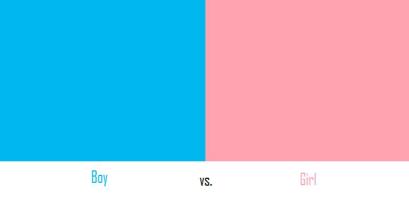Here in America, males are perceived as dominant, tough, macho. Females are supposed to act quiet, submissive, soft, and emotional. I think gender stereotypes are somewhat bullshit, especially because of the methods in which American parents encourage them.
Boys are taught to hold in their feelings, that crying means you are weak, and that trucks, motorcycles, and race cars, or other dangerous objects or playthings are “boy-like”. Girls are taught that it is okay to cry, that dolls and dress up and tea parties are “girl-like”. Pink is a “girl color” and blue is a “boy color”. Why is pink more feminine and blue more masculine? Why is a truck masculine and a horse feminine?
I have a tie-dyed pillowcase on a pillow on my bed right now. It has pink, yellow, and blue splotches of color. Guess what color my son points to and asks “what’s that?” for ninety percent of the time. Pink! To him, it is just another wavelength discernible to the naked human eye and has no gender specific meaning. Who arbitrarily chose pink and blue to be either masculine or feminine? It is ridiculous.
I try not to influence games we play by gender. He likes hide and seek, being tickled, rolling around under the blanket and playing dress up. When he brings me clothes for me to dress him up in, he brings clothes indiscriminately. He brings me my shirts to dress him up in just as often, or sometimes more often, (probably because mine are brightly colored), as he brings his father’s shirts or his own shirts. He does not care! Why should he?
Why should I also teach him that in order to be masculine, he must not cry or otherwise show his feelings? That would create a dysfunctional adult. Often the result of bottling up emotions is that later, they explode. That is not emotionally healthy. It is important to teach our boys, and girls, to cope with each emotion as it surfaces.
To teach a young boy that he should be dominant in the husband-wife relationship may later create a dysfunctional marriage. A marriage should be a partnership. Especially when children are involved, a united front should be presented. But in order to achieve a united front, the couple must discuss child raising expectations and techniques. The only way to combine those correctly is to compromise. Compromise requires team work. If the male is the dominant figure and has every say in child raising techniques and methods, there may not be balance. Moderation and balance are required for raising children to be emotionally healthy adults.
While it is true that some people prefer to live life more “on the edge” or prefer to have a more adrenaline-filled life, some people prefer to have more stable, boring lives, regardless of gender. I know just as many females who are attention-seeking “adrenaline junkies” as males. And I know just as many males who lead stable, balanced lives as females. Those things are individual preferences, not gender specific preferences. And yet some parents guide their boys one way and their girls the other because of a perceived normal cultural tendency.
As parents, we should strive to create or mold emotionally and physically healthy adults, regardless of gender. And we should not chastise our children for a color preference, emotional tendencies, etc. because of a gender specific cultural norm. We should appreciate our children for the individuals they are, and help them achieve balance and moderation throughout their lives. We need to love them all, because they are all perfect in their own way.

